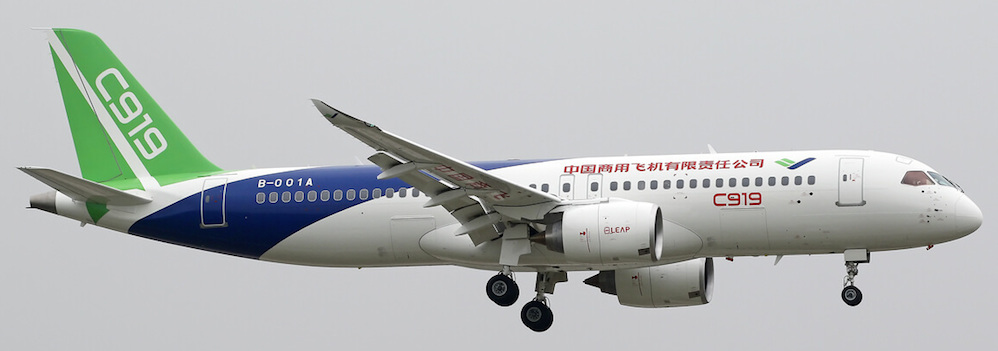The Commercial Aircraft Corporation of China (COMAC) said on February 6, 2018, that it is targeting 2021 for the first delivery of its C919 single-aisle jet, despite delays in production and flight testing. It has been a decade-long effort to build an airliner that Beijing hopes will compete against Boeing and Airbus.
Lu Zheng, COMAC’s deputy general manager of sales and marketing, told reporters on the sidelines of the Singapore Airshow 2018, that the company is expecting Chinese certification to take three to four years, Reuters reports.
Lu also said U.S. and European certification would come after it wins approval from the Chinese regulators. According to him, the European Aviation Safety Agency (EASA) has started the certification process, but the U.S. Federal Aviation Administration (FAA) has not.
Nevertheless, Lu reassured that the certification process “should not have any impact” on the delivery time to the jet’s launch customer, China Eastern airlines. Now, Lu says they are striving for the first delivery of the aircraft in 2021.
Back in November, 2016, COMAC stated that it received 570 orders for the jet from 23 customers. In June, 2017, the orders rose to a total 600 with 24 domestic and foreign customers as COMAC signed a deal for 30 C919s with EverBright Financial Leasing in Beijing.
From drawing board to take-off
China established COMAC in May, 2008, announcing plans to produce its first large commercial jetliner named the C919.
In April, 2009, COMAC finished the C919’s initial design and said it aims to send the jet on its maiden flight in 2014, according to the state-owned Beijing News.
In September of the same year, COMAC unveiled a model of the C919 aircraft for the first time at the Asian Aerospace Expo in Hong Kong.
Almost a year later, in November, 2010, China announced the C919 received its first order of 100 planes.
Production issues withheld the plane’s maiden flight at least twice since 2014, pushing first delivery dates even further.
The C919 was presented to the public for the first time in November, 2015, at a roll-out ceremony in Shanghai.
In May, 2017, the C919 successfully performed its maiden flight.
There was an almost five month gap between the airliner’s first and second flight, which once again raised concerns that COMAC’s plans to deliver the aircraft were running behind schedule.
The jet has since undergone multiple tests, including a long-distance flight.
Long road ahead
With the introduction of the C919, China’s first ever home-grown passenger jet, the state hopes to compete with Boeing’s 737 and Airbus A320 in the single-aisle jet market which continues to be dominated by the two plane making giants.
Lu described recent partnerships between Airbus and Bombardier, as well as Boeing and Embraer as “normal”, but said that they would affect the markets its C919 as well as the ARJ21 want to compete in.
“It will have an impact but they’ve also been impacted by us,” he told reporters. “We will work hard to become, from a follower, to be a competitor, and in future, if we have the opportunity, to become a leader,” nevertheless, admitting that it is “a long road”.
According to the Chinese company, the potential market for the C919 is estimated at around ¥650 billion ($96 billion). However, an analysis by Ishka Global stated that for the success of the program COMAC has to focus on such after-market infrastructures as MRO services and spare parts availability.
The company is also co-developing a new wide-body twinjet jetliner with Russia in a joint venture, between COMAC and Russia’s United Aircraft Corporation (UAC) that is known as China-Russia Commercial Aircraft International Corporation (CRAIC). This airliner is planned to be delivered by 2027. The total budget of the program is estimated to be around $13 billion, according to COMAC.
The C919 represents China’s civil aerospace ambitions and President’s Xi Jinping’s push to upgrade manufacturing capabilities. Back in 2014, while visiting COMAC’s offices, the Chinese President was reported saying that large jets are a reflection of China’s national capabilities and urged the development of a competitive aviation industry.
Source – AeroTime


